#blue sumatras
Text
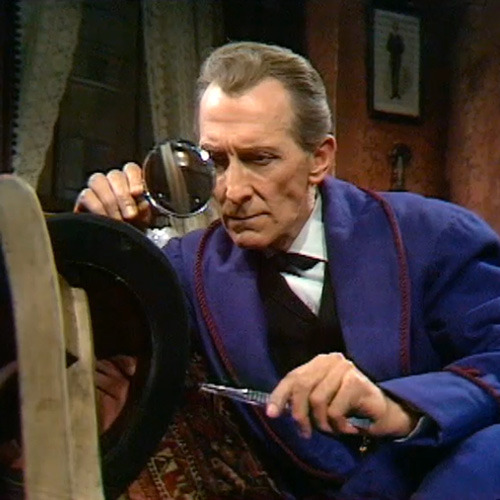





Sherlockian Wednesday Watchalongs: 🎅 HoHoHolmes
🎶🎄 Deck the halls with all the Sherlocks, fa la la la la, la la la la! 🎄🎶
Wednesday, December 6
Sherlock Holmes: The Blue Carbuncle (1968 TV episode)
Peter Cushing finishes out his run on this series with a mystery found inside a Christmas goose.
Wednesday, December 13
The Blue Carbuncle (1979 movie)
Just when you thought you'd seen all the Soviet-era musical comedy Holmes adaptations, you find out about The Other One.
Wednesday, December 20
Tales from Dickens: A Christmas Carol (1959 TV episode)
You know Basil Rathbone from his portrayal of one of the most famous characters in British literature, but now you'll see him… do that. Except with Scrooge this time.
December 24–26: 🎁 Bonus Holmes for the Holidays watchalong marathon! 🎁
Wednesday, December 27
The Great Mouse Detective (1986 movie)
It's time for our annual visit with Basil of Baker Street.
Here’s the deal: Like Sherlock Holmes? You’re welcome to join us in The Giant Chat of Sumatra’s #giantchat text channel to watch and discuss with us. Just find a copy of the episode or movie we’re watching, and come make some goofy internet friends.
Keep an eye on my #the giant chat of sumatra tag and the calendar for updates on future chat events. We'll be having more special bonus events at the end of the year!
#the giant chat of sumatra#sherlock#bbc sherlock#sherlock holmes#sherlock holmes 1965#the blue carbuncle 1979#a christmas carol 1959#the great mouse detective#watchalong#holiday special#finalproblem.tumblr.com/chat
16 notes
·
View notes
Text
Hey All,
I've been away for some time, as we've been working really hard on something quite exciting:
let me present to you the world's first ever global ocean drainage basin map that shows all permanent and temporary water flows on the planet.

This is quite big news, as far as I know this has never been done before. There are hundreds of hours of work in it (with the data + manual work as well) and it's quite a relief that they are all finished now.
But what is an ocean drainage basin map, I hear most of you asking? A couple of years ago I tried to find a map that shows which ocean does each of the world's rivers end up in. I was a bit surprised to see there is no map like that, so I just decided I'll make it myself - as usual :) Well, after realizing all the technical difficulties, I wasn't so surprised any more that it didn't exist. So yeah, it was quite a challenge but I am very happy with the result.
In addition to the global map I've created a set of 43 maps for different countries, states and continents, four versions for each: maps with white and black background, and a version for both with coloured oceans (aka polygons). Here's the global map with polygons:
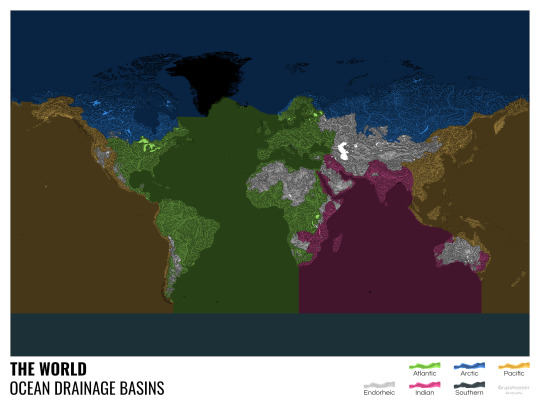
I know from experience that maps can be great conversation starters, and I aim to make maps that are visually striking and can effectively deliver a message. With these ocean drainage basin maps the most important part was to make them easily understandable, so after you have seen one, the others all become effortless to interpret as well. Let me know how I did, I really appreciate any and all kinds of feedback.
Here are a few more from the set, I hope you too learn something new from them. I certainly did, and I am a geographer.
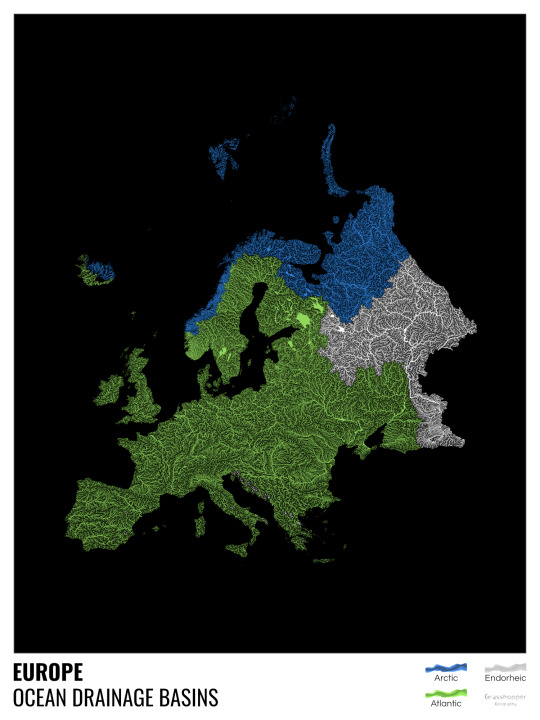
The greatest surprise with Europe is that its biggest river is all grey, as the Volga flows into the Caspian sea, therefore its basin counts as endorheic.
An endorheic basin is one which never reaches the ocean, mostly because it dries out in desert areas or ends up in lakes with no outflow. The biggest endorheic basin is the Caspian’s, but the area of the Great Basin in the US is also a good example of endorheic basins.
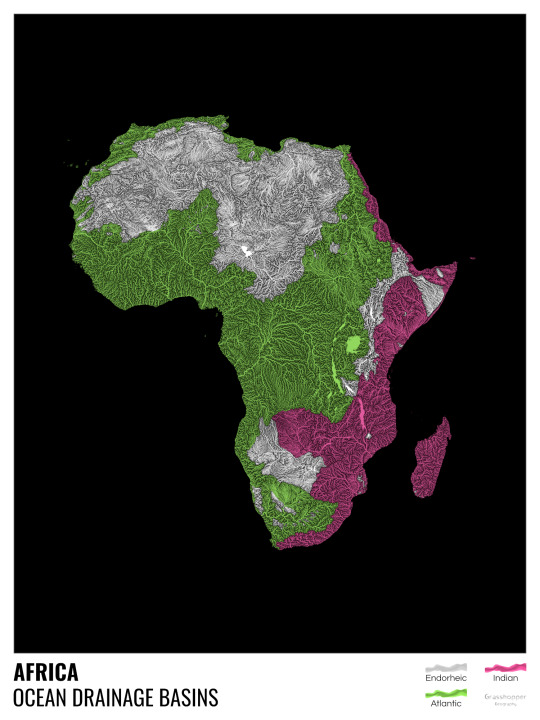
I love how the green of the Atlantic Ocean tangles together in the middle.
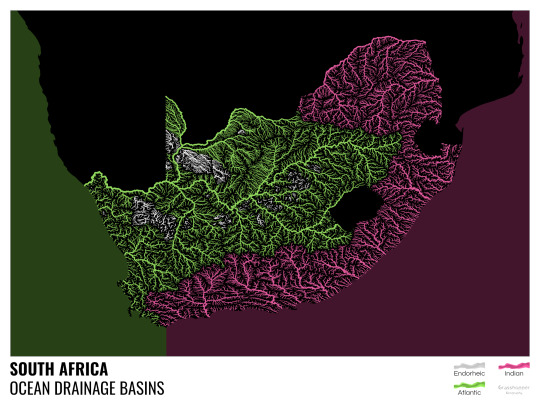
No, the dividing line is not at Cape Town, unfortunately.

I know these two colours weren’t the best choice for colourblind people and I sincerely apologize for that. I’ve been planning to make colourblind-friendly versions of my maps for ages now – still not sure when I get there, but I want you to know that it’s just moved up on my todo-list. A lot further up.

Minnesota is quite crazy with all that blue, right? Some other US states that are equally mind-blowing: North Dakota, New Mexico, Colorado, Wyoming. You can check them all out here.
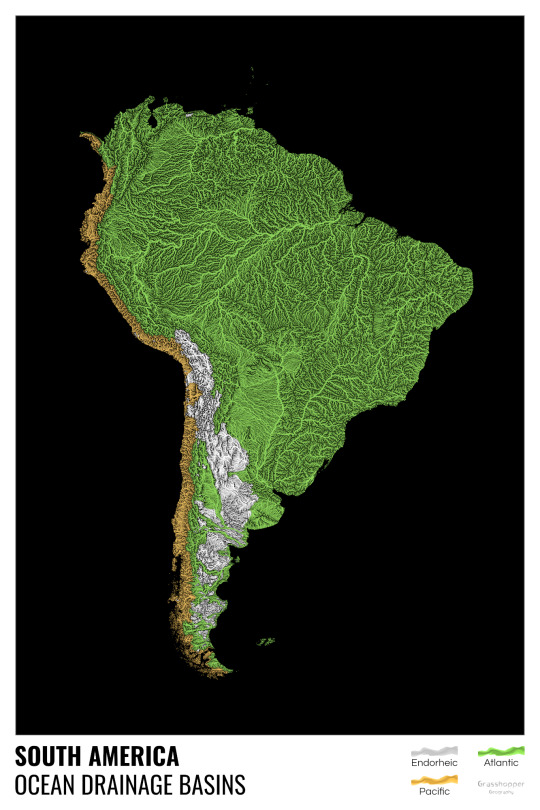
Yes, most of the Peruvian waters drain into the Atlantic Ocean. Here are the maps of Peru, if you want to take a closer look.
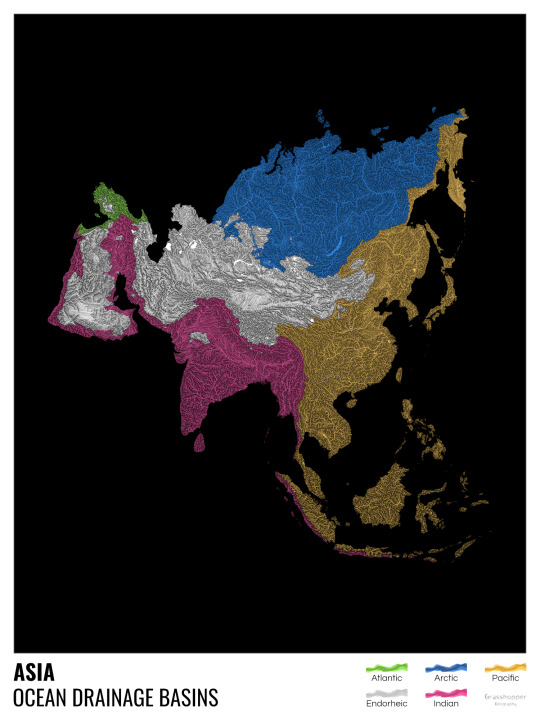
Asia is amazingly colourful with lots of endorheic basins in the middle areas: deserts, the Himalayas and the Caspian sea are to blame. Also note how the Indonesian islands of Java and Sumatra are divided.
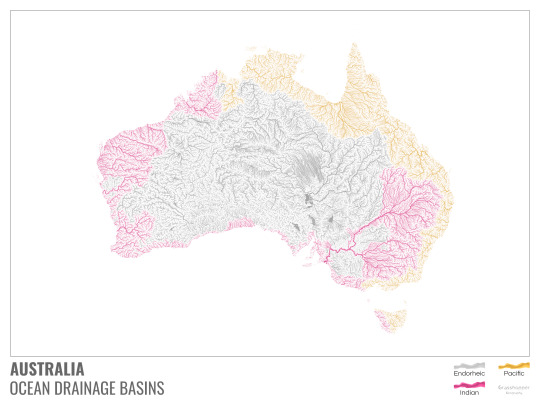
I mentioned earlier that I also made white versions of all maps. Here’s Australia with its vast deserts. If you're wondering about the weird lines in the middle: that’s the Simpson desert with its famous parallel sand dunes.
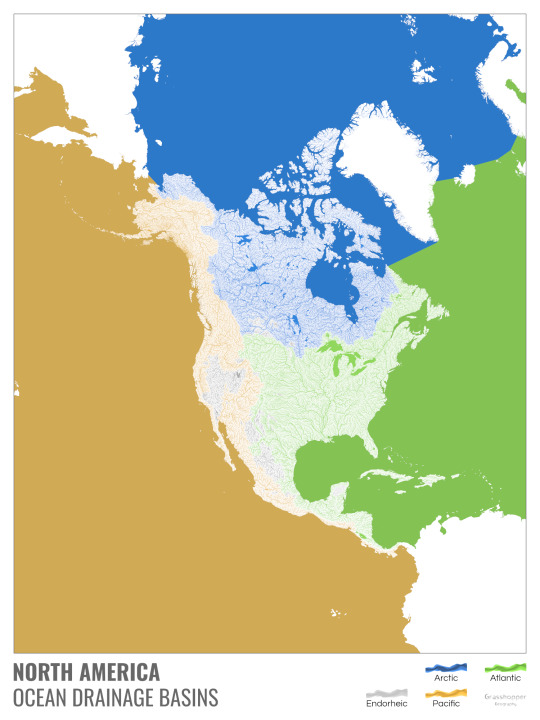
North America with white background and colourful oceans looks pretty neat, I think.

Finally, I made the drainage basin maps of the individual oceans: The Atlantic, the Arctic, the Indian and the Pacific. The Arctic is my favourite one.
I really hope you like my new maps, and that they will become as popular as my river basin maps. Those have already helped dozens of environmental NGOs to illustrate their important messages all around the world. It would be nice if these maps too could find their purpose.
#maps reimagined#geography#cartography#maps#my art#rivers of the world#ocean drainage basins#ocean maps#river maps
16K notes
·
View notes
Text
Melt Fat Like Magic: Navigating the Overnight Transformation with Weird Blue Tonic
Embark on a magical journey where excess fat simply melts away while you sleep. Welcome to the enchanting world of the Weird Blue Tonic, where overnight transformation is nothing short of extraordinary. Introducing Sumatra Slim Belly Tonic – your key to unlocking the secrets of this magical elixir. Discover the science behind melting fat like magic, ensuring you wake up to a slimmer and revitalized version of yourself every morning.
Decoding the Magic: How Weird Blue Tonic Initiates Overnight Fat Melting:
The Weird Blue Tonic, a mystical elixir, takes center stage in our exploration. Sumatra Slim Belly Tonic is your guide to decoding the magic behind this unique potion, providing a revolutionary solution for overnight fat melting.
Why Opt for Sumatra Slim Belly Tonic in Your Overnight Fat Melting Journey?
1. Enchanting Transformation: Sumatra Slim Belly Tonic is not just a product; it's a catalyst for an enchanting transformation. Fueled by the Weird Blue Tonic, this elixir initiates a remarkable change in your body overnight, making fat melt away as if by magic.
2. Magical Weight Loss: Experience weight loss with a touch of magic. Sumatra Slim Belly Tonic, powered by the Weird Blue Tonic, taps into the mystical, providing you with an extraordinary experience of fat melting as part of your nightly journey.
3. Revitalizing Sleep: It's not just about melting fat; it's about rejuvenating your body. Sumatra Slim Belly Tonic promotes restful sleep, allowing your body to recover and efficiently burn fat, leaving you revitalized for the day ahead.
4. Scientifically Crafted Formula: Choose a product grounded in science. Sumatra Slim Belly Tonic's formulation is backed by scientific research, ensuring you're on a proven path to effective and sustainable overnight fat melting.
Incorporate Sumatra Slim Belly Tonic into Your Nightly Ritual:
Make Sumatra Slim Belly Tonic an integral part of your nightly ritual for transformative results:
Evening Elixir Ceremony: Immerse yourself in the magic of the Weird Blue Tonic with Sumatra Slim Belly Tonic as part of your evening ceremony. Let the elixir work its wonders overnight, ensuring a transformative change in your body while you rest.
Restful Slumber: Enjoy a restful sleep with Sumatra Slim Belly Tonic. The Blue Tonic promotes deep, restorative sleep, allowing your body to maximize its magical fat-melting potential while you embrace the night.
Morning Marvel: Wake up to a morning marvel. Experience the extraordinary results of overnight fat melting with Sumatra Slim Belly Tonic, setting the tone for a confident and revitalized day.
Choose Sumatra Slim Belly Tonic: Your Key to Magical Fat Melting:
Embark on a journey of magical fat melting with Sumatra Slim Belly Tonic. It's not just a tonic; it's your key to unlocking the secrets of the Weird Blue Tonic – the pathway to overnight fat melting and waking up to a transformed, more vibrant you.
Click below to claim your package now
0 notes
Note
Someone told me herp is like hero.. a heroic snake ? I could imagine it and view that thought with love and enjoy the idea of a heroic snake
I CAN BE YOUR HERO BABY!!!

Crowned False Boa (Pseudoboa coronata), family Colubridae, Perú
photograph by Justin Coburn
I CAN KISS AWAY THE PAIN...

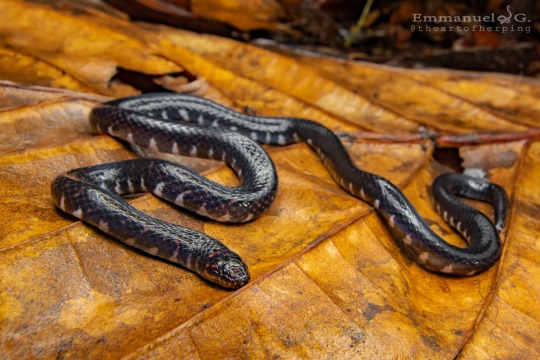
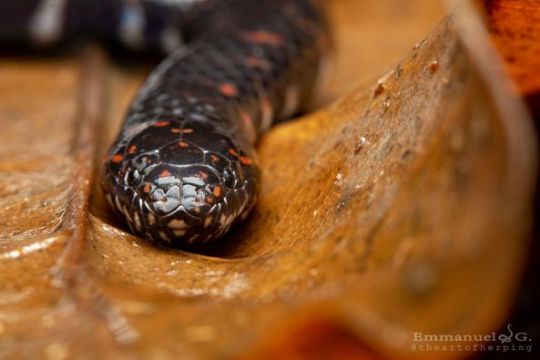
Selangor Mud Snake (Raclitia indica), family Homalopsidae, Singapore
This species is rarely seen, and had only been previously seen in Singapore in 1914, then again in 2020, and then this individual was photographed in 2024.
photograph by Emmanuel Raphael Goh
I WILL STAND BY YOU FOREVER!!!

Malayan Slug-Snake (Asthenodipsas malaccanus), family Pareidae, northern Sumatra, Indonesia
photograph by Josh Phangurha
YOU CAN TAKE... MY BREATH AWAY!!!
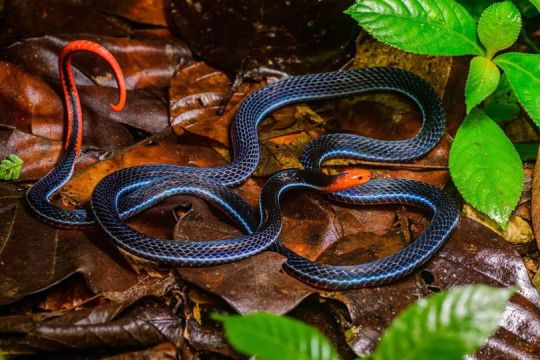
Blue Coral Snake (Calliophis bivirgatus), family Elapidae, Thailans
Venomous.
photograph by Thai National Parks
#snake#reptile#coral snake#calliophis#venomous#herpetology#slug snake#dipsidae#asthenodipsas#mud snake#raclitia#homalopsidae#colubridae#false boa#pseudoboa#animals#nature
163 notes
·
View notes
Text
The Oriental Blue Clearwing Moth: these moths were regarded as a "lost species" for more than 130 years, until they were finally sighted again in 2013
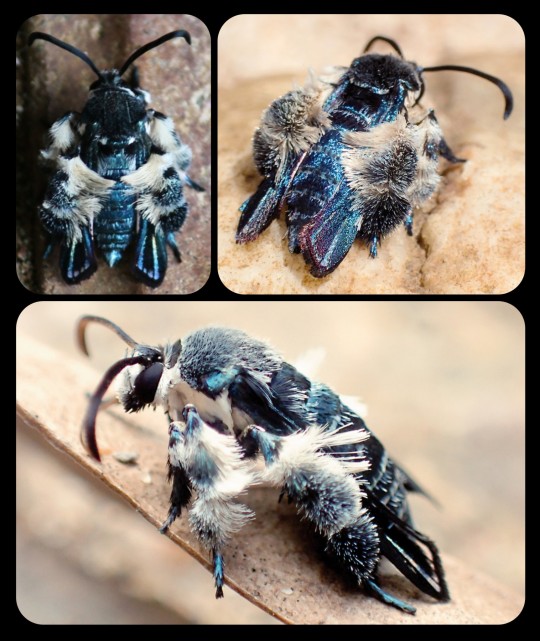
For more than 130 years, the Oriental blue clearwing moth (Heterosphecia tawonoides) was known only from a single, badly damaged specimen that was collected in Sumatra in 1887. There were no recorded sightings of this species again until 2013, when entomologist Dr. Marta Skowron Volponi unexpectedly found the moths feeding on salt deposits that had accumulated along the riverbanks in Malaysia's lowland rainforest.

These moths were observed by researchers again in 2016 and 2017, and research indicates that the moths are actually bee-mimics, as they mimic the appearance, sound, behavior, and flight patterns of local bees. Their fuzzy, bright blue appearance might seem a little out of place for a bee-mimic, but those features do appear in several different bee species throughout Southeast Asia.
When the moths are in flight, they bear a particularly strong resemblance to the bees of the genus Thyreus (i.e. cuckoo bees, otherwise known as cloak-and-dagger bees), several of which are also bright blue, with banded markings, dark blue wings, fuzzy legs, and smooth, rounded antennae. The physical resemblance is compounded by the acoustic and behavioral mimicry that occurs when the moths are in flight.
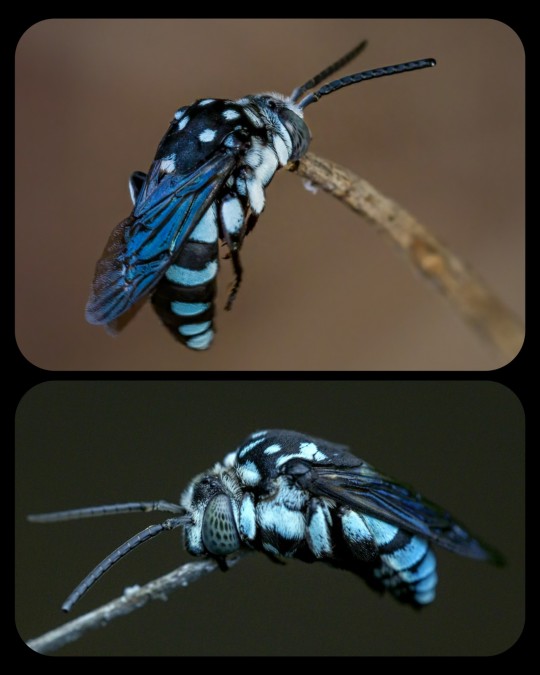
Cloak-and-Dagger Bees: the image at the top shows an Indo-Malayan cloak-and-dagger bee (Thyreus novaehollandiae) in a sleeping position, holding itself upright with its mandibles clamped onto a twig, while the image at the bottom shows a Himalayan cloak-and-dagger bee (T. himalayensis) resting in the same position
The moths also engage in "mud-puddling" among the various bees that congregate along the riverbanks; mud-puddling is the process whereby an insect (usually a bee or a butterfly) draws nutrients from the fluids found in puddles, wet sand, decaying plant matter, carrion, animal waste, sweat, tears, and/or blood. According to researchers, the Oriental blue clearwing moth was the only lepidopteran that was seen mud-puddling among the local bees.
Dr. Skowron Volponi commented on the unusual appearance and behavior of these moths:
You think about moths and you envision a grey, hairy insect that is attracted to light. But this species is dramatically different—it is beautiful, shiny blue in sunlight and it comes out during the day; and it is a master of disguise, mimicking bees on multiple levels and even hanging out with them. The Oriental blue clearwing is just two centimeters in size, but there are so many fascinating things about them and so much more we hope to learn.
This species is still incredibly vulnerable, as it faces threats like deforestation, pollution, and climate change. The president of Global Wildlife Conservation, which is an organization that seeks to rediscover "lost species," added:
After learning about this incredible rediscovery, we hope that tourists visiting Taman Negara National Park and picnicking on the riverbanks—the home of these beautiful clearwing moths—will remember to tread lightly and to take their trash out of the park with them. We also recommend that Americans learn about palm oil production, which is one of the primary causes of deforestation in Malaysia.
Sources & More Info:
Phys.org: Bee-Mimicking Clearwing Moth Buzzes Back to Life After 130 Years
Mongabay News: Moth Rediscovered in Malaysia Mimics Appearance and Behavior of Bees to Escape Predators
Journal of Tropical Conservation Science: Lost Species of Bee-Mimicking Clearwing Moth, H. tawonoides, Rediscovered in Peninsular Malaysia's Primary Rainforest
Frontiers in Zoology: Southeast Asian Clearwing Moths Buzz like their Model Bees
Royal Society Publishing: Moving like a Model - mimicry of hymenopteran flight trajectories by clearwing moths of Southeast Asian rainforests
Medium: Rediscovery in a Glint of Blue
re:wild.org: The "Search for Lost Species" Project
#lepidoptera#moths#heterosphecia tawonoides#oriental blue clearwing moth#entomology#insects#cute bugs#nature#animals#lost species#mimicry#evolution#bees#southeast asia#Malaysia#colorful moths#bee mimic#science
78 notes
·
View notes
Text

Salamander, of the elemental variety
In terms of elemental forms it is a mistake to approach from a position of evolutionary taxonomy. As in all transitions from perpendicular realities, such creatures are born from and induce the mythological symbols that define their anatomy.
The concept manifests the symbol, the symbol communicates the concept, an oroboros of cause and effect that is no less existentially annoying for creating animals made of the idea of fire, which is so certain of itself it doesn't know that it shouldn't be able to burn your house down.
In practical terms, a salamander should be addressed in the same manner as a grease fire, by entrapping it in a fireproof metal vessel and blocking the oxygen flow. Without a source of oxygen, the creature will poof back to its native reality. Any major brand of charcoal briquette is adequate bait. Oily rags, old newspapers, and pre-1975 furniture will do in a pinch.
-Melinoë's Guide to Incursive Pests & Misidentified Phenomenon, 2005 edition.
Prompt and process under the fold.
Prompt: colorful smoke swirling off of a black background, in the style of fluid glass sculptures, light teal and orange, tangled forms, light red and blue, rendered in cinema4d, sculpture-based photography, distorted and elongated forms:: fullbody, a colorful smoke swirl with colorful lights on a dark background, in the style of fluid, glass-like sculptures, light cyan and orange, serge marshennikov, colorful layered forms, conrad shawcross, focus stacking, bold lines, bright colors:: a real Charmander, dinosaur with burning tail, salamander, dino-iguana, glowing flames, rocky terrain, sumatraism, lava tail, burning tail, background sharp earth, raptor, elegant pose, hawaii, outback, iguana, morning glow, stock photo, regal pose --ar 4:3 --s 50 --v 6.0
This prompt was made two autogenerated prompts I made from this image I made by blending smoke and glass textures with Midjourney's weird image prompting system:

The image also had image prompts, in this case, three different charmanders, two being experiments for a Harryhausen Pokemon "what if" pictorial set and one being a "real animal version" attempt:
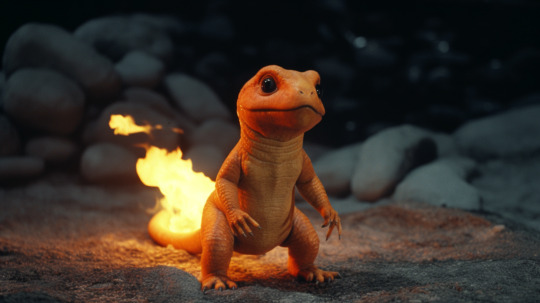
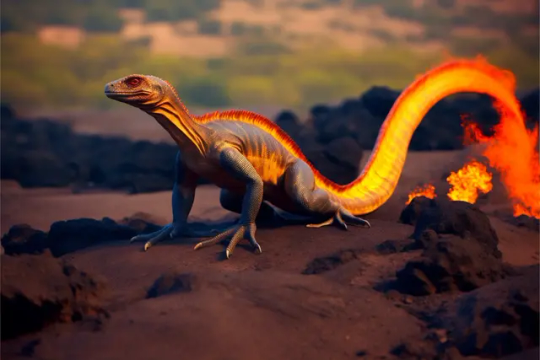
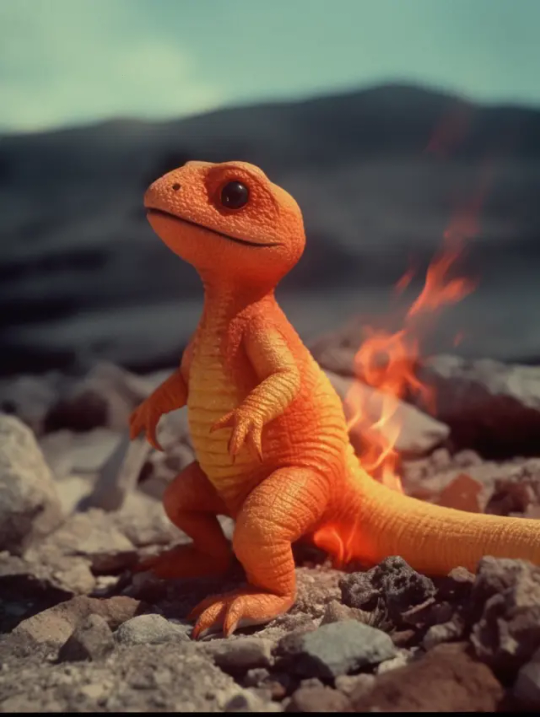
And those are from multiple versions of MJ.
Eventually, resulting in this gen:

Which I composited with multiple other variants, rebuilt the claw and some other details, and then did color correction and processing.
#midjourney v6#generative art#unreality#microfiction#salamander#elemental#fantasy#mythology#charmander#midjourney edit#ai assisted art
22 notes
·
View notes
Text
WIP Tag Game
I was kindly tagged by @aloveforjaneausten and @sanguinarysanguinity in the following game, which... presumes I can keep track of all my WIPs.
Rules: post the names of all the files in your WIP folder, regardless of how non-descriptive or ridiculous. Let people send you an ask with the title that most intrigues them, and then post a little snippet or tell them something about it! and then tag as many people as you have WIPs.
My wips:
Believing the Lovely Idea
Water Like A Stone
Golf Girl
Learning the Business
A Different Kind of Folly
a still and woven blue
Care of Future Times
everything | that has not yet been lost
winnowing oar
Das Heil, das auf dem Land ich suche
anticolonial femslash thing
Dime Novel/Damsel Does The Rescuing
Elementary!Sumatra
Fake Renaissance Paintings
Unfridging Project
Greenwood Encounters
1950s post-espionage country house BatB
Tagging: @jomiddlemarch, @tinydooms, @qqueenofhades, @huntercombe, @cycas, @the-moon-loves-the-sea and... why do I blank people's handles when doing these things? I always feel as though there's more AO3/Tumblr crossover than I reliably remember. If you'd like to consider yourself tagged, please do feel free.
#my academic publishing schedule REALLY cramps my fic-writing schedule#i don't know how qqueenofhades does it#wip tag game
15 notes
·
View notes
Text
Backyard Chickens: A Master Post
So you want your own little dinosaurs to eat your table scraps and make breakfast for you in the sunny months. Well! I am here to provide a quick starter to getting your own flock set up - and yes, for urban chickens as well.
Things to consider:
What can you have? Local laws usually dictate how many chickens can be kept per household/acre. Laws can vary by state and city. Look this up first. You can usually keep more bantams (miniature chickens) than their full-size cousins, and with chickens being so social I do recommend bantams for urban/suburban yards.
What weather will they be exposed to? Indoor chickens can generate a lot of dust, but small outdoor coops can be difficult to heat safely. Dual purpose breeds are usually more cold-hardy than layer varieties, and everybody likes fresh water and shade in the heat. Frozen water bottles left outside to thaw can keep birds cool, too.
What will eat them? I have had little losses to foxes, personally, and more to neighborhood dogs. Raccoons are nearly everywhere in North America and will tear open fences to eat your babies. (I would know. I've had to deal with the aftermath.) Rabbit hutches are a good starter for bantams, but a good coop made of wood and a yard made of hardware cloth or dog fence panels (and with netting on top for hawks/owls) will keep out most things. Weasels/mink will fit through gaps bigger than an inch, so be careful of that, too.
What do they need? Chickens love to scratch and forage (and some can fly short distances and modest heights) so if you're letting them on the lawn be prepared for them to eat it - no pesticides on that turf! At night, they prefer to sleep on perches/something with a bit of height to it and do best locked in their coop where other critters can't eat them. A place to nest and lay their eggs in their coop (otherwise they will find their own little secret place, God help you find it) and a place to dust-bathe (like chinchillas) to help keep mites and lice out of their feathers. They'll also need some grit and calcium - crushed oyster shell (or their own eggshells) will help.
Where can I get them? Many farm and feed stores like Tractor Supply Company will sell baby chicks during the spring, but if you're looking for specific bantams or unusual breeds I recommend checking out your State Fair or a Poultry Association show [American version located here] and check it out. They're free admission, generally, and almost every show has people who bring birds to sell. While the demographics tend to slant pretty "red" I have seen plenty of blue hair and pronouns at poultry shows. Facebook can also be a great resource.
How do I get everyone to get along? Chickens are notoriously territorial, with a vicious pecking order that make Mean Girls a documentary. Chickens who are raised from chicks together will get along best, but if you need to add more I would introduce two or more at a time (so the newbies have a friend) and put them in a nearby yard/cage for a few days until everyone has worked out their opinions through the bars of a cage. Some breeds are sweeter than others (buff orpington) and some are.... spicy (Plymouth rocks).
Saro's Personal Breed Recommendations
Dual Purpose (cold weather) - Black Australorps , Buff Orpington, New Hampshire Reds are all generally pretty good natured and calm. The platonic ideal of a chicken.
Layer breeds (warm weather) - Leghorns are the go-to, but I have a soft spot for Hamburg as well. And of course, who wouldn't love a chicken who lays dark brown (Marans) or green/blue (Ameraucauna) eggs?
Bantams - D'Anvers with their little beards are my all time favorite and have the biggest personalities in my experience, but Old English Game (even more zippity) and Black Sumatras (all black, even down to the skin, and shockingly calm in hand) are high on the list as well. And everyone loves the fluffy-faced Silkie or feather footed Cochin.
Hopefully this is enough to get you started! Feel free to send me questions or add on with a couple of your own tips (especially non-US people and those with indoor chickens). I've been raising them for eggs, pets, and for show since 2005, but I am always eager to learn.
61 notes
·
View notes
Text

On this day:
FOO FIGHTERS
On December 23, 1944, the War Diary of the American 415th Night Fighter Squadron recorded numerous incidents involving foo fighters flying over Germany. British and German pilots also experienced the bothersome blazing fireballs, which were colored white, red, orange, blue, green, or yellow. The fireballs would shoot up from below or down from above the war planes, darting through their formations and occasionally interfering with the aircrafts' electronics. Comic strip character Smokey Stover coined the expression, "Where there's foo, there's fire," thus bestowing the name foo fighters on the phenomenon.
One event involved a Beaufighter whose pilot watched as two enormous fiery lights flew up from the ground toward his plane. They leveled off and stuck with him in spite of his dives and attempts to lose them. In two minutes they peeled off, climbing out of sight.
Other encounters include a foo fighter, six feet in diameter, flying over Sumatra; six green and red lights in a T formation following an aircraft through several turns and miles before vanishing; a patroling Beaufighter with red and white lights flying on each side of him; and a crew who watched ten distant pinpoints of light grow to basketball size and change from glowing orange to red in color.
The foo fighters were also seen and reported by German pilots to their commanders.
Text from: Almanac of the Infamous, the Incredible, and the Ignored by Juanita Rose Violins, published by Weiser Books, 2009
8 notes
·
View notes
Note
Please bless me with knowledge about blue chickens my beloved if you have any
There is 3 different genes that dilute black to "blue" i will talk about two of them
Blue (BL) is a dominant gene that is different in its heterozygous and homozygous form. Birds who are heterozygous for blue are what is known as "Blue" while birds that are homozygous are known as "Splash"
Blue can be difficult to work with since breeding two blue birds together can produce Splash birds which can be tricky if your breed standard doesnt allow homozygous blue birds. Blue also ranges from a very dark grey to a very light almost white grey with many shades inbetween depending on other genes and the base color at play. This means that Blue doesnt always breed true.
Here is a Blue (heterozygous) australorp next to a typical black one
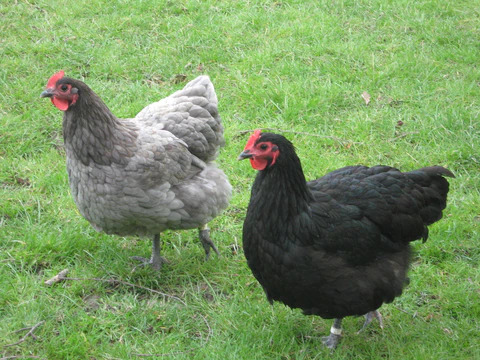
and here is a Blue next to a Splash (homozygous)

Splash and Blue birds periodically have to be crossed back to black birds to retain color. Birds who are not eventually crossed back can fade to basically white which is why alot of breeders try to avoid having only splash and blue birds. What some breeders do is that they will also have a blue and a black pen where they raise high quality birds so whenever the blues need more blacks the breeder already has some good birds to choose from.
When two blue (BL) chickens are bred they will produce around
50% Blue (heterozygous birds)
25% black (no blue gene)
25% Splash (homozygous birds)
When you breed a Splash to a black bird you get
100% Blue
When you breed a Splash to Splash to get
100% Splash
You can see that splash birds can still have their place in the breeding pen (with crossing to black birds) since they can produce you more blues, the individuals might not be popular at some shows but hobby keepers love them so they always have a place.
Second gene that dilutes black to blue is one of my favorite genes and that is Lavender (lav) which is also known as Self Blue which is an autosomal recessive which only expresses in its homozygous form.
Lavender is the only gene that dilutes both black and red pigments and its works by preventing the black and red pigments from entering the feather rather then altering the pigment itself (like blue does)
Since lavender breeds true,meaning if your breed two lavender together they will produce more lavenders, you can create very delicate blue and gold shades with lavender so its very popular to use in color projects.

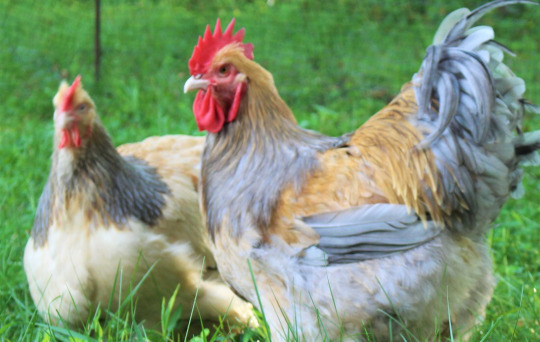

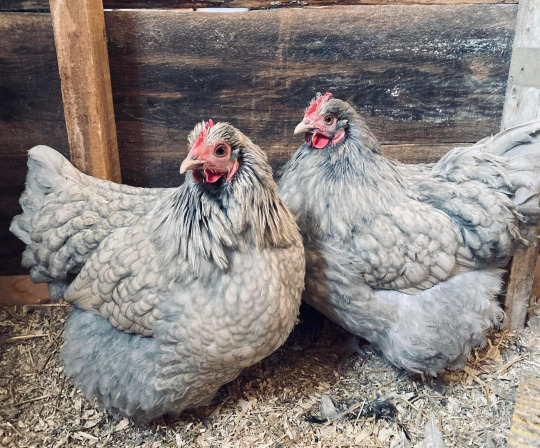
lavender isnt without its own trickiness though. The dreaded "feather shredder" or "tail shredder gene" is thought to be closely linked to lavender. Lavender doesnt cause tail shredder but it is thought that the gene tethers to lavender very easily likely due to the fact that pigment helps strengthen feathers and lavender birds are deficient in pigment
This is what tail shredder looks like. It can happen to any bird(this is a black sumatra), even one that doesnt carry lavender but its important if you breed lavender birds to always breed birds with good feather quality. Crossing a lavender bird back to a black bird just hides the problem, birds with the shredder gene shouldnt be used for breeding as this gene can easily ruin lines if introduced.
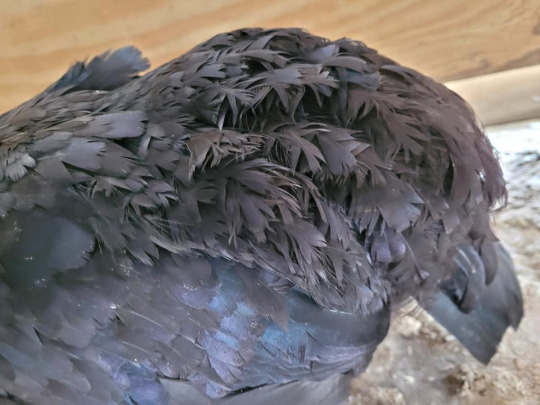
143 notes
·
View notes
Text



Sherlockian Wednesday Watchalongs: 🎅 HoHoHolmes
The Blue Carbuncle (1979 movie)
Just when you thought you’d seen all the Soviet-era musical comedy Holmes adaptations, you find out about The Other One.
We’ll watch and chat live at 8:30 pm US Eastern time (click for your local date/time).
Anyone is welcome to join us, even if you've randomly discovered this post. See you in The Giant Chat of Sumatra’s #giantchat Discord channel!
#the giant chat of sumatra#sherlock#bbc sherlock#sherlock holmes#the blue carbuncle 1979#watchalong#finalproblem.tumblr.com/chat
12 notes
·
View notes
Text

Tacua speciosa is a very large species of cicada, native to Malaysia, Indonesia, Singapore and the islands of Borneo, Sumatra and Java.
It is among the largest cicadas in the world, with a head-body length of 4.7–5.7 cm (1.9–2.2 in) and a wingspan of 15–18 cm (5.9–7.1 in). This species has black wings, and some striking features such as a yellow-green collar, a red transversal stripe on the thorax and a turquoise-blue abdomen.
📷 @ennisanna_fei
68 notes
·
View notes
Text
I know Sumatra Slim Belly Tonic is backed by science, but are you sure it’ll work for me?
Sumatra Slim Belly Tonic contains ingredients that are proven to work, regardless of whether you’re twenty, forty, or eighty, and no matter your weight or background. So, yes. I’m 100% sure this will work for you, that’s why I’m letting you try this breakthrough formula completely risk-free. It’s simple, If, within 90 days, you are not totally thrilled with your results, let me know and you’ll receive every invested penny back, even if the bottle is empty…That’s why it’s a no-brainer, you simply have nothing to lose, except for unwanted body fat, doesn’t that sound fair? So, go ahead
and experience these amazing results for yourself…
Don’t delay…
Click below to claim your package now
👉 Discover The Best Supplement To Lose Belly Fat 👈
0 notes
Text
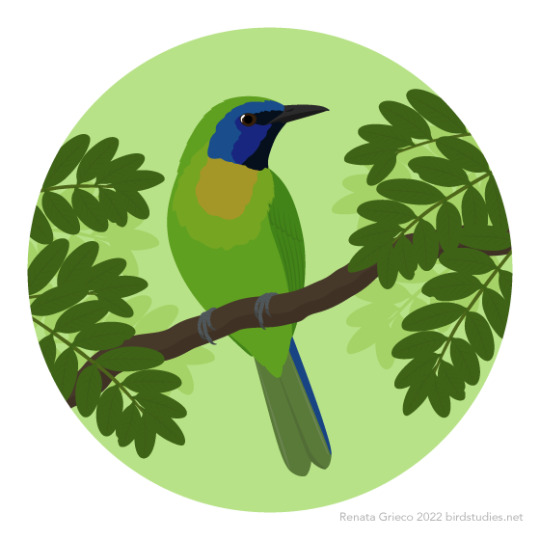
July 3, 2022 - Blue-masked Leafbird (Chloropsis venusta)
Found on the island of Sumatra in Indonesia, these leafbirds inhabit foothill forests. Foraging in pairs in the canopy, they eat fruit, seeds, and arthropods. Their breeding behavior has not been observed but other species of leafbird build their nests at the ends of branches near the crowns of trees. They are classified as Near Threatened by the IUCN due to deforestation and capture for trade.
72 notes
·
View notes
Text
🌟 Spark Your Weight Loss Journey with Sumatra Slim Belly Blue Tonic! 💥
Ready to bid farewell to stubborn pounds and spark a journey of newfound confidence? Sumatra Slim Belly Blue Tonic is your ultimate spark for achieving rapid weight loss! 💪
Crafted to accelerate your progress, this potent elixir targets stubborn fat, sparks metabolism, and reinvigorates energy levels. Join the league of users who have witnessed phenomenal transformations, experiencing visible changes and reclaiming their spark.
Don't let doubt dim your journey! Experience the transformative spark of Sumatra Slim Belly Blue Tonic today and unlock your full potential. Begin your adventure on the official website now! ⏳✨"
#FitnessJourney#FitLife#GymMotivation#WorkoutGoals#ExerciseRoutine#FitInspiration#FitnessCommunity#FitnessAddict#FitFam#FitGoals#FitnessProgress#FitAndHealthy#FitnessMotivation#FitnessGoals#FitnessLifestyle#ExerciseInspiration#FitBody#FitnessTransformation#FitnessTips#FitnessChallenge
2 notes
·
View notes
Text

✨cool bug facts's✨
Trogonoptera Brookiana, or the Rajah Brooke's birdwing!
They look like Santa Clause with a red beard from this angle.🎅👨🦰
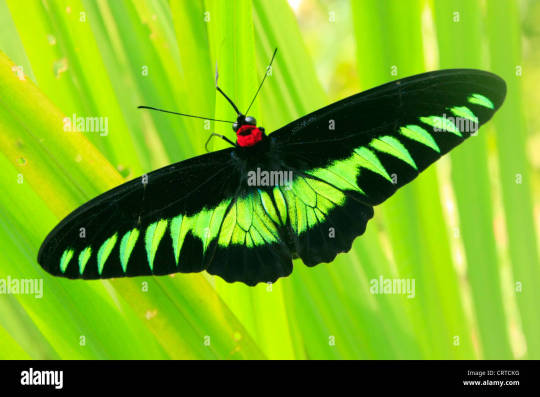
The anatomy of these 💸remunerative💸 insects!!!
The females are usually brownish with white on the tips of their forewings and on the base of their hindwings. But in some species the females look just like the males, but with blue wings instead of green.
The pupae are as green as the male's wings with streaks of violet.
The larvae have a fork-shaped mound on the back of their head that secretes a pungent and poisonous liquid that deters predators.
They have evolved to be immune to the poison in the Aglaia foveolata, which is where they get their poisonous liquid from.
They grow red hairs on their head, giving them the appearance of a red collar. (Are all insects redheads?)
Diet.
They eat the nectar from flowers like the Bauhinia.
The larvae eat the Dutchman's pipe and the leaves from the Aglaia foveolata.
Behavior.
The males tend to congregate around one area, making the chances of seeing just a singular Rajah Brooke's birdwing very low.
The females don't leave their trees very often, unlike the males, making the chances of seeing a female compared to the chances of seeing a male 1/200.
While they tend to stick very close to one another, they will not react if one of their own dies.
While the Aglaia foveolata's leaves are poisonous to humans, the Rajah Brooke's birdwing will not use their poison on humans.
Habitat.
They inhabit Thai-Malay Peninsula, Borneo, Natuna, Sumatra, Banyak, Simeulue, Batu, and Mentawai.
They are Malaysia's national butterfly.
They live in tropical rainforests, and like to hang around any good sources of minerals, namely hot Sulphur springs.
I initially had many more fact's than this, I was very proud of the amount of fact's I had gathered, perhaps too proud. I had written all of the fact's that I have bore upon this post onto a sheet of paper, but I had found more fact's that I, foolishly, did not write down, but I had still written them onto this post. Or I had tried to, but I had such a multitudinous array of tabs open, that my tumblr found itself crashed and I had been given a notification to close my tabs. I was so enraged that I found myself to have lost my will, my will to write all the fact's I had so tenderly collected, and so I had felt unable to continue my work for a sprinkling of days, and still my final project is not nearly as extensive or informative as it should've been, and from that day forth, whenever a Trogonoptera Brookiana comes into my vision, I feel an insufferable rage, despite this being of my own fault for never closing my accursed tabs. The only boon I have been given from this ordeal is that I have learned a very valuable lesson, from this day forth, about closing my tabs.
Anyway, I will be trying to post much more frequently.💖💖💖
#bugs#insects#butterfly#butterflies#rajah brooke's birdwing#trogonoptera brookiana#bugblr#entomology#lepidopterology#cool bugs#cool bug facts#cool bug's#cool bug fact's
31 notes
·
View notes